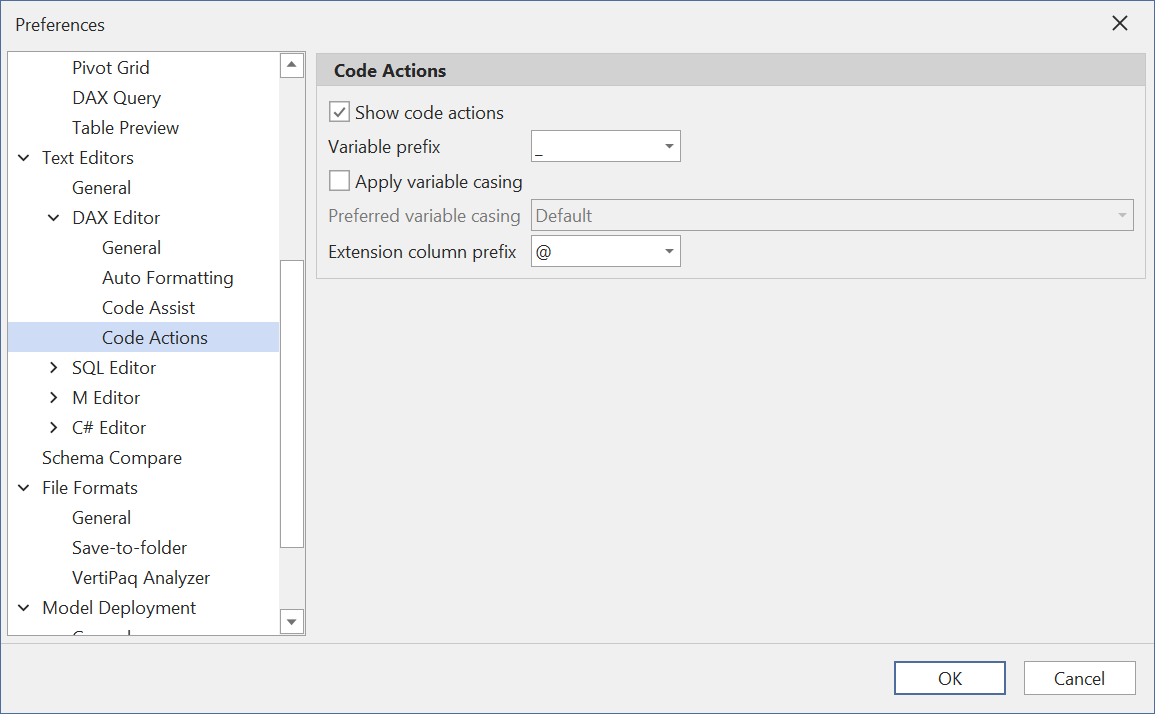Code Actions
Tabular Editor 3.18.0 introduces a new feature called Code Actions. This feature is enabled by default but can be disabled in the Tools > Preferences dialog under Text Editors > DAX Editor > Code Actions.
Code Actions is a productivity feature that discretely provides suggestions for improving your DAX code. You can apply the suggestions with a single click. Code Actions also provides easy access to common code refactoring operations.
Code Actions are separated into three different categories:
- Improvements: These are recommended suggestions for improving your DAX code in terms of:
- Following best practices
- Avoiding common pitfalls and anti-patterns
- Avoiding obsolete or deprecated DAX features
- Writing better, more performant DAX code
- Readability: These are suggestions for making your DAX code more readable by...
- Simplifying complex expressions, when possible
- Remove redundant or unnecessary code
- Applying consistent formatting and naming conventions
- Rewrites: These are suggestions for refactoring your DAX code. They are not necessarily improvements but are often useful for larger code refactorings. Examples are:
- Convert DAX "syntax sugar" to more verbose but more explicit code
- Rename all occurrences of a variable or an extension column
- Format code
How to use Code Actions
A new command and corresponding toolbar/menu buttons have been added, Show Code Actions, with a default keyboard shortcut of Ctrl+.. This command will show the applicable Code Actions at the current cursor position:
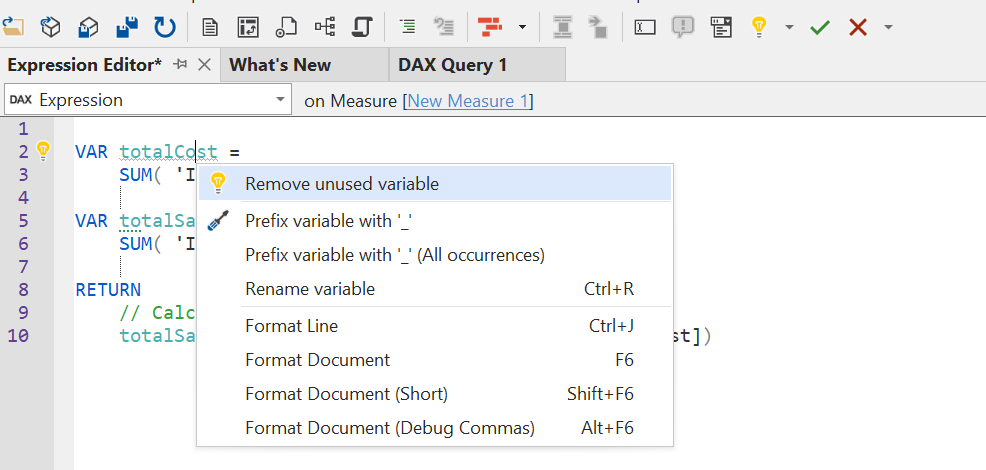
You can also find the applicable Code Actions through the Refactor submenu of the right-click context menu:
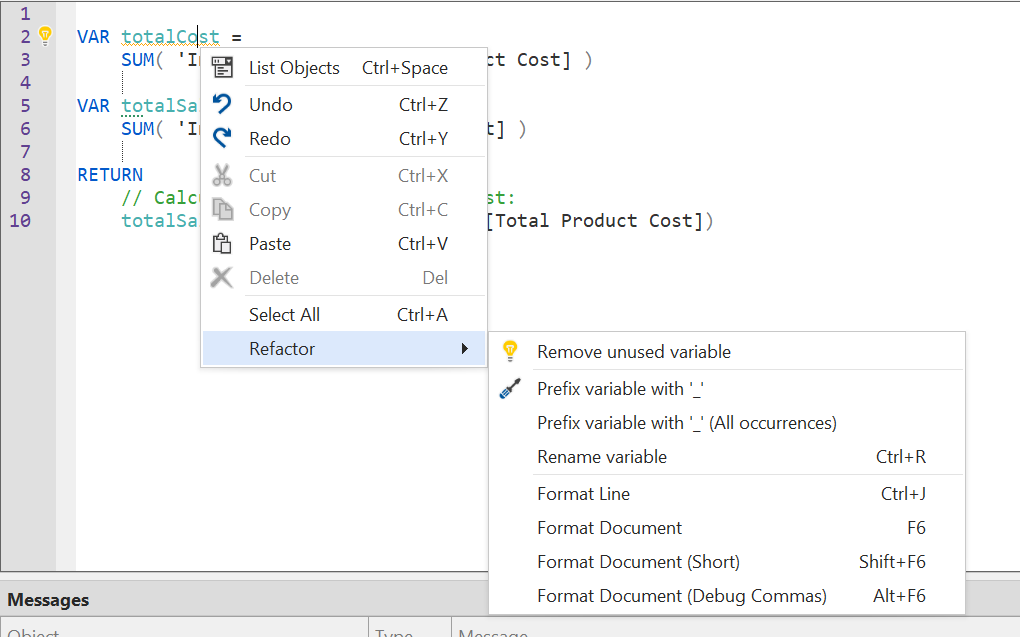
Lastly, a lightbulb or screwdriver icon is shown in the editor's left margin when the cursor is placed on a code segment with applicable actions. Clicking on the icon will also bring up the Code Actions menu:
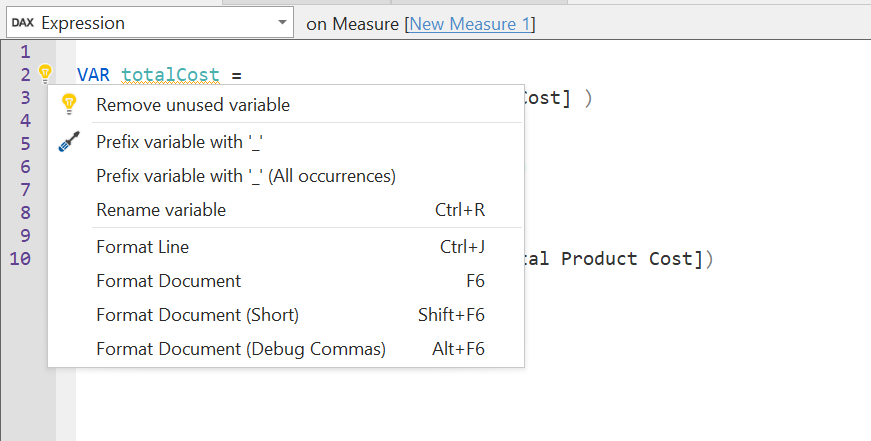
When you hover the mouse cursor over an action in the Code Actions menu, a tooltip will show more information about the action. Click the "Learn more" link, to view the knowledge-base (KB) article for the action.
 ]
]
Code Action indicators
Improvements and Readability Code Actions will also be indicated visually in the code editor. This lets you quickly determine which parts of your code can be improved or made more readable.
- Improvements are shown with orange dots under the first few characters of the code segment (unless that code segment already displays an orange warning squiggly). A lightbulb icon will appear in the left margin when the cursor is moved over the code segment.
- Readability actions are shown with teal green dots under the first few characters of the code segment. When the cursor is moved over the code segment, a screwdriver icon will appear in the left margin.
- Rewrites are not visually indicated in the code itself; however, the screwdriver icon will appear in the left margin when the cursor is placed on a code segment with applicable rewrites.
Apply to all occurrences
Some Code Actions can be applied to all occurrences within the current DAX expression, DAX script, or DAX query rather than just the code segment under the cursor. When this is the case, the Code Action will be shown in the Code Actions menu with " (All occurrences)" appended to the action description. Clicking on the action will apply the change to all occurrences in the document.
In the screenshot below, for example, the Prefix variable with '_' action can be applied to all occurrences (i.e., all variables) in the document, not just the totalSales variable under the cursor:
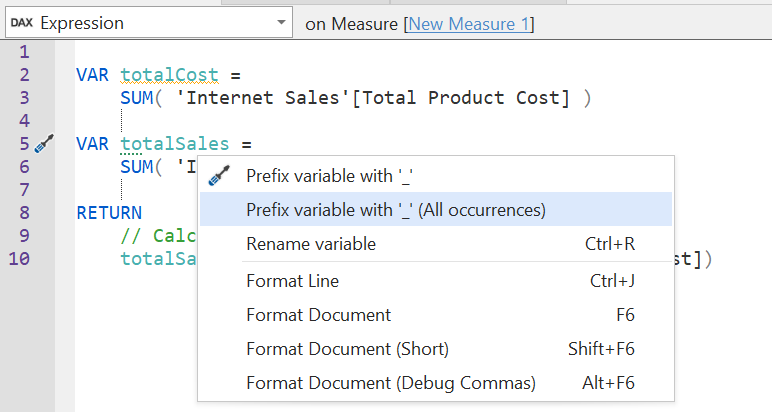
List of Code Actions
The table below lists all currently available Code Actions. You can toggle off Code Actions in the Tools > Preferences dialog under Text Editors > DAX Editor > Code Actions (a future update will let you toggle individual actions for a more customized experience). Some Code Actions also have additional configuration options, such as which prefix to use for variable names.
Improvements
The Code Actions below will appear with orange dots under the first two characters of the applicable code and a lightbulb icon in the left margin when the cursor is placed on the code segment:
| ID | Name | Description |
|---|---|---|
| DI001 | Remove unused variable | Variables not referenced anywhere should be removed. Example:VAR a = 1 VAR b = 2 RETURN a -> VAR a = 1 RETURN a |
| DI002 | Remove all unused variables | Variables that are not being used (directly or indirectly through other variables) in the RETURN part of a variable block should be removed. Example:VAR a = 1 VAR b = a RETURN 123 -> 123 |
| DI003 | Remove table name | Measure references should not include the table name, as the table name is unnecessary when referencing measures. Moreover, this practice makes measure references more easily distinguishable from column references. Example:Sales[Total Sales] -> [Total Sales] |
| DI004 | Add table name | Column references should include the table name to avoid ambiguities and to more easily distinguish column references from measure references. Example:SUM([SalesAmount]) -> SUM(Sales[SalesAmount]) |
| DI005 | Rewrite table filter as scalar predicate | A common anti-pattern in DAX is to filter a table inside a CALCULATE filter argument when it is sufficient to filter one or more columns from that table. Example:CALCULATE([Total Sales], FILTER(Products, Products[Color] = "Red")) -> CALCULATE([Total Sales], KEEPFILTERS(Products[Color] = "Red"))This Code Action supports various variations of the original expression. |
| DI006 | Split multi-column filter into multiple filters | When filtering a table on multiple columns combined using AND (or the equivalent && operator), better performance can often be achieved by specifying multiple filters, one for each column. Example:CALCULATE(..., Products[Color] = "Red" && Products[Size] = "Large") -> CALCULATE(..., Products[Color] = "Red", Products[Size] = "Large") |
| DI007 | Simplify SWITCH statement | A SWITCH statement that specifies TRUE() for the <Expression> argument, and where all <Value> arguments are simple comparisons of the same variable/measure, can be simplified. Example:SWITCH(TRUE(), a = 1, ..., a = 2, ...) -> SWITCH(a, 1, ..., 2, ...) |
| DI008 | Remove superfluous CALCULATE | A CALCULATE function that is not necessary because it does not modify the filter context, or because an implicit context transition would happen anyway, should be removed. Examples:CALCULATE([Total Sales]) -> [Total Sales]AVERAGEX(Product, CALCULATE([Total Sales])) -> AVERAGEX(Product, [Total Sales])Also applies when the first argument of CALCULATE / CALCULATETABLE is a DAX variable, e.g.:VAR x = [Total Sales] RETURN CALCULATE(x, Product[Color] = "Red") ->VAR x = [Total Sales] RETURN x |
| DI009 | Avoid calculate shortcut syntax | Example:[Total Sales](Products[Color] = "Red") -> CALCULATE([Total Sales], Products[Color] = "Red") |
| DI010 | Use MIN/MAX instead of IF | When a conditional expression is used to return the minimum or maximum of two values, it is more efficient and compact to use the MIN or MAX function. Example:IF(a > b, a, b) -> MAX(a, b) |
| DI011 | Use ISEMPTY instead of COUNTROWS | When checking if a table is empty, it is more efficient to use the ISEMPTY function than to count the rows of the table. Examples:COUNTROWS(Products) = 0 -> ISEMPTY(Products) |
| DI012 | Use DIVIDE instead of division | When using an arbitrary expression in the denominator of a division, use DIVIDE instead of the division operator to avoid division by zero errors. Example:x / y -> DIVIDE(x, y) |
| DI013 | Use division instead of DIVIDE | When the 2nd argument of DIVIDE is a non-zero constant, it is more efficient to use the division operator. Example:DIVIDE(x, 2) -> x / 2 |
| DI014 | Replace IFERROR with DIVIDE | Use the DIVIDE function instead of IFERROR to provide an alternate result when a division has a zero denominator. Example:IFERROR(x / y, 0) -> DIVIDE(x, y, 0) |
| DI015 | Replace IF with DIVIDE | Use the DIVIDE function instead of IF to more easily check for zero or blank in the denominator. Example:IF(y <> 0, x / y) -> DIVIDE(x, y) |
Readability
The Code Actions below will appear with teal green dots under the first two characters of the applicable code and a screwdriver icon in the left margin when the cursor is placed on the code segment
| ID | Name | Description |
|---|---|---|
| DR001 | Convert to scalar predicate | A column filter can be written more concisely as a scalar predicate without explicitly using the FILTER function. Examples:FILTER(ALL(Products[Color]), Products[Color] = "Red") -> Products[Color] = "Red"FILTER(VALUES(Products[Color]), Products[Color] = "Red") -> KEEPFILTERS(Products[Color] = "Red") |
| DR002 | Use aggregator instead of iterator | Use an aggregator function instead of an iterator function when possible to simplify the code. Example:SUMX(Products, Products[SalesAmount]) -> SUM(Products[SalesAmount]) |
| DR003 | Use VALUES instead of SUMMARIZE | When SUMMARIZE only specifies a single column, and that column belongs to the table specified in the first argument, the code can be more concisely written using VALUES. Example:SUMMARIZE(Products, Products[Color]) -> VALUES(Products[Color]) |
| DR004 | Prefix variable | Variables should use a consistent naming convention. It is recommended to use a prefix, such as an underscore. You can configure which prefix to use to match your preferred style. Example:VAR totalSales = SUM(Sales[SalesAmount]) -> VAR _totalSales = SUM(Sales[SalesAmount]) |
| DR005 | Prefix temporary columns | Using a consistent prefix for temporary columns is recommended to more easily distinguish them from base columns or measures. You can configure which prefix to use to match your preferred style. Example:ADDCOLUMNS(Product, "SalesByProd", [Sales]) -> ADDCOLUMNS(Product, "@SalesByProd", [Sales]) |
| DR006 | Move constant aggregation to variable | When an aggregation function is used inside an iterator or a scalar predicate, the aggregation produces the same result for every row of the iteration. Therefore, the aggregation could be moved to a DAX variable outside of the iteration. Example:CALCULATE(..., 'Date'[Date] = MAX('Date'[Date])) ->VAR _maxDate = MAX('Date'[Date]) RETURN CALCULATE(..., 'Date'[Date] = _maxDate) |
| DR007 | Simplify 1-variable block | A variable block with only one variable can be simplified by moving the expression directly into the RETURN part of the block. This assumes the variable is only referenced once without any context modifiers. Example:VAR _result = [Sales] * 1.25 RETURN _result -> [Sales] * 1.25 |
| DR008 | Simplify multi-variable block | A variable block with multiple variables where each is a simple measure reference, which is only used once in the RETURN section without any context modifiers, should be simplified. Example:VAR _sales = [Sales] VAR _cost = [Cost] RETURN _sales - _cost -> [Sales] - [Cost] |
| DR009 | Rewrite using DISTINCTCOUNT | Instead of using COUNTROWS(DISTINCT(T[c]) to count the number of distinct values in a column, use the DISTINCTCOUNT function. |
| DR010 | Rewrite using COALESCE | Instead of using IF to return the first non-blank value from a list of expressions, use the COALESCE function. Example:IF(ISBLANK([Sales]), [Sales2], [Sales]) -> COALESCE([Sales], [Sales2]) |
| DR011 | Rewrite using ISBLANK | Instead of comparing an expression with BLANK(), use the ISBLANK function. Example:IF([Sales] = BLANK(), [Budget], [Sales]) -> IF(ISBLANK([Sales], [Budget], [Sales]) |
| DR012 | Remove unnecessary BLANK | Some DAX functions, such as IF and SWITCH already return BLANK() when the condition is false, so there is no need to explicitly specify BLANK(). Example:IF(a > b, a, BLANK()) -> IF(a > b, a) |
| DR013 | Simplify negated logic | When a logical expression is negated, it is often more readable to rewrite the expression using the negated operator. Example:NOT(a = b) -> a <> b |
| DR014 | Simplify using IN | Rewrite compound predicates (equality comparisons of the same expression that are combined using OR or ||) with the IN operator. Example:a = 1 || a = 2 || a = 100 -> a IN { 1, 2, 100 } |
Rewrites
The Code Actions below will appear with a screwdriver icon in the left margin when the cursor is placed on the code segment.
| ID | Name | Description |
|---|---|---|
| RW001 | Rewrite TOTALxTD using CALCULATE | Functions such as TOTALMTD, TOTALQTD and TOTALYTD can be rewritten using the CALCULATE function, which is more expressive and provides greater flexibility. Example:TOTALYTD([Total Sales], 'Date'[Date]) -> CALCULATE([Total Sales], DATESYTD('Date'[Date])) |
| RW002 | Rewrite using FILTER | A scalar predicate in a filter argument to CALCULATE can be rewritten using FILTER. This is useful, for example, when you need to add more complex filtering logic. Example:CALCULATE(..., Products[Color] = "Red") -> CALCULATE(..., FILTER(ALL(Products[Color]), Products[Color] = "Red")) |
| RW003 | Invert IF | To improve readability, it is sometimes useful to invert IF statements. Example:IF(a < b, "B is greater", "A is greater") -> IF(a > b, "A is greater", "B is greater") |
Customizing Code Actions
You can customize the behavior of Code Actions through the Tools > Preferences dialog under Text Editors > DAX Editor > Code Actions. Here, you can toggle the feature on and off and configure additional options for some Code Actions, such as the prefix to use for variable names and extension columns.
We plan to add more configuration options to this screen in future versions, such as an option to toggle individual Code Actions on and off. Stay tuned!
